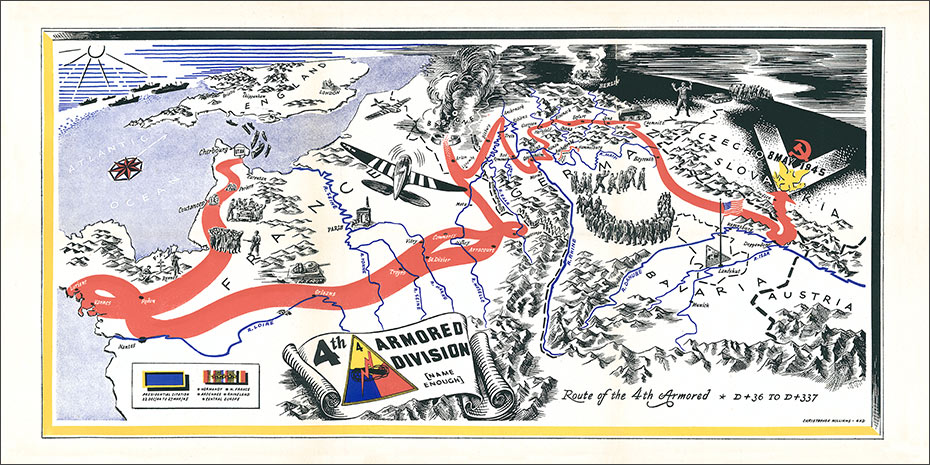4th Armored DIVISION - Breakthrough
Activated 15 Apr 1941 • Entered Combat 17 Jul 1944 Normandy • Days of Combat 230 • Casualties 6,212
Commanding Generals
Maj. Gen. H. W. Baird (Apr 41 - May 42)
Maj. Gen. J. S. Wood (May 42 - Dec 44)
Maj. Gen. Hugh J. Gaffey (Dec 44 - Mar 45)
Maj. Gen. W. M. Hoge (Mar 45 - Jun 45)
Brig. Gen. B. L. Clarke (Jun 45 - Jul 45)
Brig. Gen. W. Lyn Roberts (Jul 45 - Sep 45)
Campaigns
Normandy (6 Jun 44 - 24 Jul 44)
Northern France (25 Jul 44 - 14 Sep 44)
Rhineland (15 Sep 44 - 21 Mar 45)
Ardennes-Alsace (16 Dec 44 - 25 Jan 45)
Central Europe (22 Mar 45 - 11 May 45)
Campaign Map of the 4th Armored Division
This campaign map shows the route of the 4th Armored Division throughout France, and Germany during World War II. This chart is available for purchase at HistoryShots.com.
Division Chronicle
After training in England from January to July 1944, the 4th Armored Division landed at Utah Beach 11 July 1944 and entered combat 17 July, driving to and securing the Coutances area, 28 July, The Division then swung south to take Nantes, cutting off the Brittany Peninsula, 12 August 1944. Turning east, it drove swiftly across France north of the Loire, smashed across the Moselle 11-13 September, flanked Nancy and captured Luneville, 16 September. After maintaining a defensive line, Chambrey to Xanrey to Henamenil, from 27 September to 11 October, the Division rested briefly before returning to combat 9 November with an attack in the vicinity of Viviers. The 4th cleared Bois de Serres, 12 November, advanced through Dieuze and crossed the Saar, 21-22 November, to establish and expand bridgehead and took Singling and Bining before being relieved 8 December. Two days after the Germans launched their Ardennes offensive, the 4th Armored entered the fight (18 December 1944), racing northwest into Belgium, covering 150 miles in 19 hours. The Division attacked the Germans at Bastogne, helping to relieve the besieged 101st Airborne. Six weeks later the Division jumped off from Luxembourg City in an eastward plunge that carried it across the Moselle River at Treir, , south and east to Worms, and across the Rhine, 24-25 March 1945. Advancing all night, the 4th crossed the Main River the next day, south of Hanau, and continued to push on. Lauterbach fell 29 March, Creuzburg across the Werra on 1 April, Gotha on the 4th, and by 12 April the Division was across the Saale River. Pursuit of the enemy continued and by 6 May the Division had crossed into Czechoslovakia, established a bridgehead across the Otara River at Strakonice, with forward elements at Pisek. After a tour of occupational duty, the 4th returned to the United States for inactivation, some of its elements, however, remaining as occupation forces after redesignation as constabulary units.
Date Activated is the date the division was activated or inducted into federal service (national guard units).
Casualties are number of killed, wounded in action, captured, and missing.
The dates after the campaign name are the dates of the campaign not of the division.
The Army Almanac: A Book of Facts Concerning the Army of the United States; , U.S. Government Printing Office. Army Battle Casualties and Nonbattle Deaths in World War II, Final Report, 1 December 1941 - 31 December 1946. US Army Center of Military History at http://www.history.army.mil/ Various divisional histories


